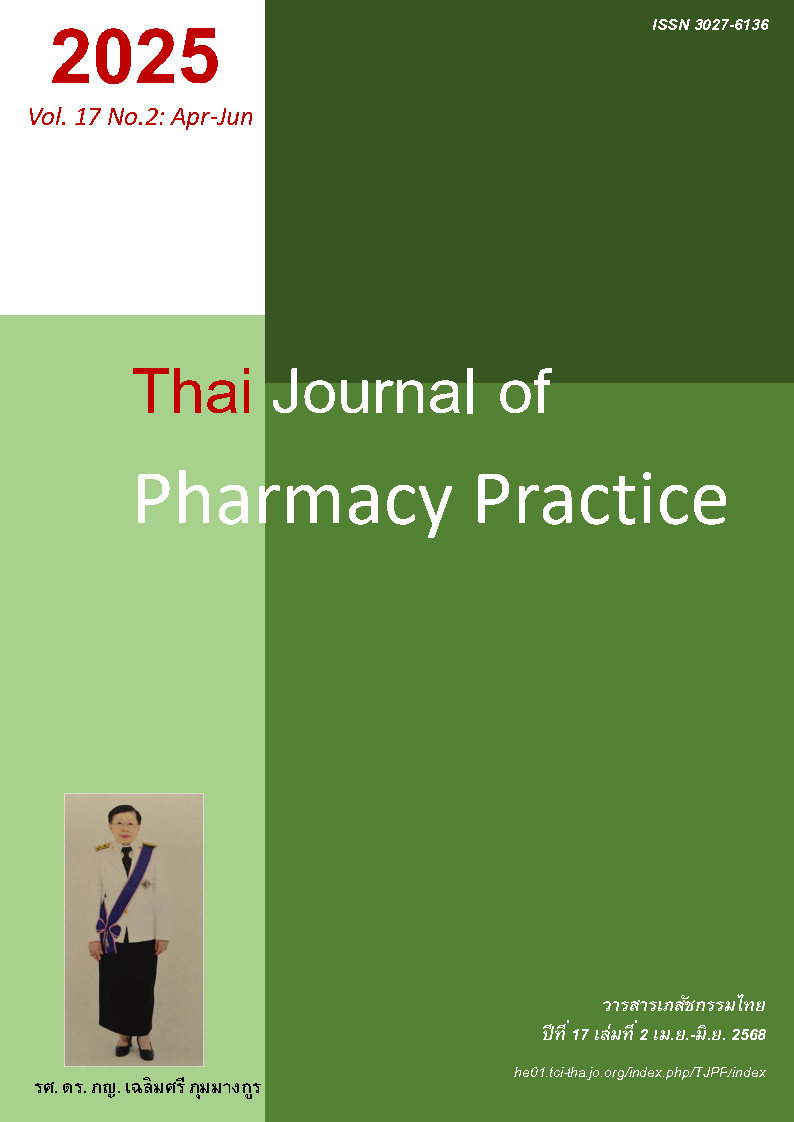Predictors of the Results of Pharmacy Licensure Examination for the First Time among Pharmacy Students of Prince of Songkla University
Main Article Content
Abstract
Objective: To identify factors related to the results of the Pharmacy License Examination in the first time among pharmacy students of Prince of Songkla University (PSU). Method: The subjects were pharmacy students of PSU in the classes of 2016 and 2017, both in pharmaceutical care (PC) and industrial pharmacy (IP) programs. The dependent variables were the results of the exams according to the core competency criteria (CC), both test of knowledge with multiple choice questions (called CC1) and test of professional skills (CC2), and those according to specific competency criteria in PC and IP, both test of knowledge with multiple choice questions (PC1 and IP1, respectively) and test of professional skills (PC2 and IP2, respectively). The predictive factors were year of admission, gender, program of study, admission methods (admis), cumulative GPA in high school, cumulative GPA over 4 academic years (GPA-4 years for CC exams) or cumulative GPA over 5 academic years (GPA-5 years for PC and IP exams) and grades of 4-5 courses identified by faculties in the Faculty of Pharmacy as having the content consistent with that of exams. Data analysis was conducted using multiple logistic regression. Receiver operating characteristic curve technique was used to determine the appropriate cutoff point. Results: Among 244 subjects who took the CC exam, 92.7, 82.8 and 80.3% of them passed the CC1, CC2, and overall CC exams (passing both CC1 and CC2), respectively. Statistically significant factors predicting overall CC exam results were GPA-4 years and the admission method. An increase of 0.1 unit in GPA-4 years was associated with the increased chance of passing the overall CC exam by 1.54 times. Students who were admitted based on the score of entrance exam (admis=1) had a 3.44 times higher chance of passing the CC exam than those admitted without the consideration of such scores (admis=0). The predictive equation, (4.5*GPA-4 years) + 1.20 admission, with a cut-off score of 14.35 exhibited sensitivity and specificity of 75 and 73 percent respectively. Among 98 students taking the PC exam, 91.8, 98.0 and 89.8% passed the PC1, PC2 and overall PC exams, respectively. The only significant predictor of the overall PC exam results was grade in the course of Pharmacotherapy and Pharmacy Practice 4. Cut-off points at grade C+ showed a sensitivity of 89% and a specificity of 70%. Among 132 students taking the IP exam, 95.5, 99.3, and 94.7% passed the IP1, IP2, and IP exams, respectively. The significant predictor of overall IP exam results was GPA-5 years. The cut-off point at grade 3.12 showed a sensitivity of 64% and a specificity of 71%. Conclusion: Significant predictive factors of the overall CC exam results were GPA-4 years and admission methods. Predictive factor for the overall PC exam results was grade in Pharmacotherapy and Pharmacy Practice 4, while that of the overall IP exam results was GPA-5 years. Faculty of Pharmacy can use these factors to set up a system to provide support for students at risk of failing the exams.
Article Details

This work is licensed under a Creative Commons Attribution-NonCommercial-NoDerivatives 4.0 International License.
ผลการวิจัยและความคิดเห็นที่ปรากฏในบทความถือเป็นความคิดเห็นและอยู่ในความรับผิดชอบของผู้นิพนธ์ มิใช่ความเห็นหรือความรับผิดชอบของกองบรรณาธิการ หรือคณะเภสัชศาสตร์ มหาวิทยาลัยสงขลานครินทร์ ทั้งนี้ไม่รวมความผิดพลาดอันเกิดจากการพิมพ์ บทความที่ได้รับการเผยแพร่โดยวารสารเภสัชกรรมไทยถือเป็นสิทธิ์ของวารสารฯ
References
Pharmacy Council. Manual on skills according to the criteria for professional knowledge and abilities of pharmacy practitioners B.E. 2562. Nonthaburi, HR Print and Training; 2019.
Regulations of the Pharmacy Council on revocation of degree accreditation of pharmacy educational institutions, B.E. 2563. Royal Gazette No. 128, Part 4D special (Jan 14, 2011).
Faculty of Pharmacy, Prince of Songkla University. Strategic plan 2019 – 2022 [online]. 2019 [cited Jul 9, 2023]. Available from: qa.pharmacy.psu.ac.th/ima ges/blog/sar/strategy_Plan_2019-2022.pdf
Chalongsuk R, Sriuttha P. Relationships between academic achievement and pharmacy license exami nation performance. Thai Pharmaceutical and Health Science Journal 2007; 2: 77-82.
Khamprakob U, Thitawan O, Nilwas W. Predictive factors of the results of examination of applicants for registration as pharmacy practitioners of students at Chiang Mai University. Chiang Mai: Faculty of Pharmacy, Chiang Mai University; 2005.
Phuntuwate W, Anuwong K. Factors affecting achievement of pharmacy license examination. Thai Pharmaceutical and Health Science Journal 2013; 8: 163-74.
Swets JA. Measuring the accuracy of diagnostic systems. Science 1988; 240:1285-93
Lobo JM, Jiḿenez-valverde A, Real R. AUC: a misleading measure of the performance of predictive distribution models. Glob Ecol Biogeogr 2008; 17: 145–51.
Youden WJ. Index for rating diagnostic tests. Cancer 1950; 3: 32–5.
Meekai N, Kaewtai N, Saiphanit S, Kornkaew K, Bumrungchaichana W. Factors affecting to the results of thai traditional medicine license tests. Boromarajonani College of Nursing, Uttaradit Journal 2021; 13: 189-98.
Konsanit S. Predictors of license examination results of new graduates in 2020, department of physical therapy, University of Phayao. Mahidol R2R e-Journal 2022; 9: 66-76.
Park SK, Phillips J, Pavuluri N. Systematic review of predictors of success for the North American Pharmacist Licensure Examination. Am J Pharm Educ 2021; 85: 8591. doi: 10.5688/ajpe8591.
Concato J, Peduzzi P, Holford T, Feinstein A. The importance of events per independent variable in proportional hazards regression analysis: I. Background, goals and general strategy. J Clin Epidemiol 1995; 48: 1495-501.
Ogundimu EO, Altman DG, Collins GS. Adequate sample size for developing prediction models is not simply related to events per variable. J Clin Epidemiol. 2016; 76: 175-82. doi: 10.1016/j.jclinepi. 20 16.02.031.

